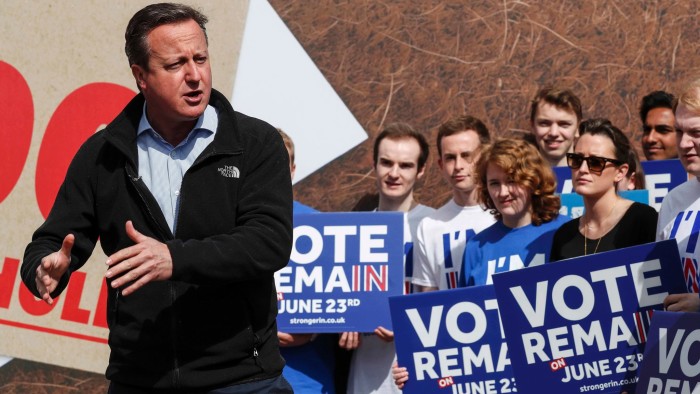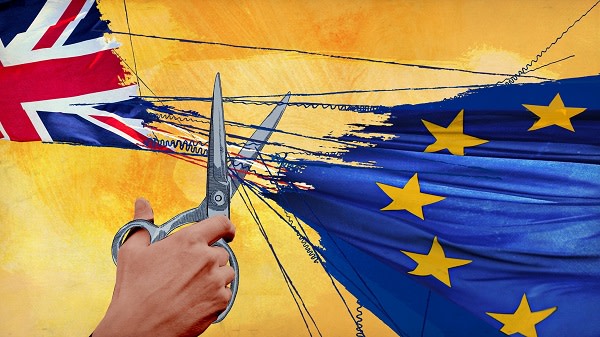On the In-side: the campaign to keep Britain in the EU

Roula Khalaf, Editor of the FT, selects her favourite stories in this weekly newsletter.
When Craig Oliver walked into an office in a City of London lane just south of St Paul's Cathedral on May 27, it marked the formal fusion of the fight to keep Britain in the EU and to save David Cameron’s premiership.
The prime minister’s pugnacious press secretary was now formally on loan to Britain Stronger In Europe — the campaign against Brexit — and had just 27 days to sharpen its message and help preserve his boss’s career.
Over recent days the mood in the “remain” camp has become edgy, as opinion polls fuel the feeling that momentum for Brexit is growing. “Of course we’re worried,” said one senior campaigner.
Mr Oliver, a former BBC news executive, calls the shots at the remain headquarters, but even before May 27 it already had the feel of a Conservative party war room: many of the ideas and personnel behind the successful 2015 election campaign had been deployed.
The Tory takeover began on February 20, the day after Mr Cameron secured his renegotiation deal with the rest of the EU. The remain operation is sophisticated and will be crucial in getting out the anti-Brexit vote.
But there are big questions over whether it is equipped to mobilise the 9m people who voted Labour at the last election and who are now flirting with Brexit, with growing fears that a Conservative-led campaign to stay in the EU has left them cold.
Stephen Gilbert — the Conservatives’ election campaign director — joined when the remain campaign started to gear up last autumn under the leadership of Labour and Liberal Democrat staffers. But Tory aides were constrained until the prime minister said which side he was on.
His announcement that he considered the EU renegotiation successful was the trigger for Tory resources to pour into what one Conservative activist had dismissively characterised as a campaign led by “the people who lost the general election”.
Although Tory strategist Sir Lynton Crosby is not involved, Mr Gilbert and Mr Oliver watched his work closely during last year’s election. The anti-Brexit campaign has implemented the Australian’s strategy: defining its message early, focusing on the economy, and disciplined repetition of the same message to saturation point.
Stronger In has also inherited the sophisticated techniques used by the Conservatives in 2015, specifically those developed by Jim Messina, the US data king who ran Barack Obama’s successful 2012 re-election campaign.
Mr Messina’s innovative fusion of technology and politics led Google chairman Eric Schmidt to call the 2012 race “the best-run campaign ever”.
Mr Messina himself is based in the US and only occasionally appears in London. Staffers joke that Mr Obama paid for the development of the Messina campaign system and that they are “getting it for free”. One said: “It’s really powerful if you know what you’re doing. And Jim knows what he’s doing.”
The system takes hundreds of facts about individual voters — from shopping patterns to newspaper readership — and uses them to estimate how likely they are to vote and whether they are likely to vote to remain in the EU.
Those with a higher “remain” score than their turnout rating will receive literature or a phone call encouraging them to vote. If the voter has a higher turnout score but a lower remain rating, the Messina algorithm will target them with a different message to persuade them to vote against Brexit.
The ground war is overseen by Tory Stuart Hand and Claire Hazelgrove from Labour with 85 staff organising local volunteers.
“Some of us thought at the beginning a ground war would be impossible to build from scratch, but we were wrong,” said a senior campaigner.
The early scepticism appeared well-founded: when the campaign held its first grass roots events in December they consisted of just six meetings in volunteers’ homes. But by now there are up to 1,500 volunteer-led events taking place across the country each week.
Leave campaigners say the anti-Brexit ground war may be visible — for example activists are a common sight at some commuter stations — but it is not well-targeted.
Spending has been split between digital campaigning, leaflets, phone calls and billboard advertising, with Mr Messina’s techniques being used to work out which method is most effective for different voter groups.
Digital tactics are another inheritance from the Conservatives’ election campaign, which considerably outspent other parties on social media advertising, particularly on Facebook. Their digital adviser Craig Elder intends to repeat this in the referendum.
————————-
UK’s EU Referendum: How people would vote

For a more detailed summary of opinion polling visit the FT’s Brexit poll tracker page
————————-
Facebook enables political campaigners to address a large number of people directly and encourage them to share publicity materials. Polling shows that undecided voters place great importance on the views of their friends and family, and Facebook helps people share those opinions.
“If you want to spend all day making Vines or managing a pretty Instagram account, great — but if you’re trying to reach a 40-year-old mum of two in Derby North who doesn’t use either platform, you’re wasting your time,” Mr Elder said after the election. “You’re much more likely to reach her on Facebook, in the evening, when the kids have gone to bed.”
The plan seems to be working: a single video on the Britain Stronger In Europe Facebook page has had over 4.6m views.
But Brexit campaigners say the Remain side is “throwing money” at Facebook messages aimed at young voters who are notoriously difficult to reach. “It’s a sign of desperation,” said Paul Stephenson of Vote Leave, the official Brexit group.
Pollsters predict that turnout will be the decisive factor for whether Britain remains in the EU — and whether Mr Cameron stays in Downing Street — after June 23: the higher it is, the more likely the remain side will win.
With polls showing a very narrow gap between the two sides, the campaign’s staffers from all parties are now focused primarily on making sure people vote.
“It is going to be close, there’s no two ways about it,” one staffer said. “Nobody should be under any illusion about that.”
————————-
UK’s EU referendum: full coverage and analysis

View the FT’s comprehensive guide to the vote on whether Britain should stay in Europe, with all the latest news, analysis and commentary from both sides of the debate. See more
————————-
Comments